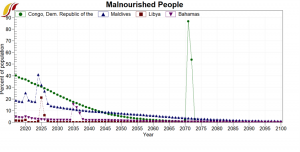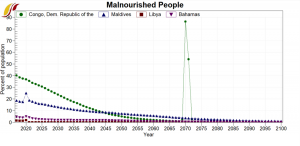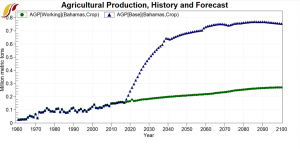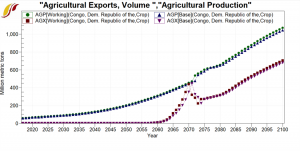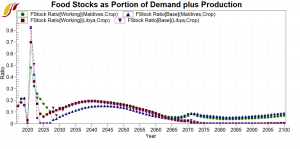Version 7.90 IP3 (September 9th, 2022): Difference between revisions
Norah.Shamin (talk | contribs) No edit summary |
Yutang.Xiong (talk | contribs) No edit summary |
||
| Line 47: | Line 47: | ||
== Data Updates == | == Data Updates == | ||
[[Category:Versions]] | |||
Revision as of 23:16, 24 April 2024
PREVIOUS VERSION | INDEX PAGE | NEXT VERSION
You can download IFs Version 7.90 IP3 at 7.90 IP3.
Interface Updates
Model Updates
- Added moving average to Reduction Factor affecting components affected by shortage in Agriculture module, smoothing problem with DRC.
- Added minimum land area to account for rapid cropland growth in many small-island states.
- Old model (7.85) but also in other versions
- New model with combination of fixes
- New production dynamics in Bahamas with additional fix
- Remaining issues on agricultural exports in DRC (no need to fix this now)
- Fix for Libya and Maldives to avoid food stocks going to zero
- Using millions $ in formula for Total Stock of Arms (bilateral).
- Allow for Ukraine to break constraint
- Fix on Agriculture Stock-Flow logic, example DRC:
The problem we were facing was a spike in Congo, malnourishment in 2070. This was a result of strong increases in price from food and agricultural stocks going to zero. For congo, in particular, a low starting level of agricultural exports meant that excess production went to very high levels of stocks. Over time, but with a lag, exports started increasing resulting in a very strong feedback to exports that after increasing enough from the seed level meant that the country starting exporting their entire production. This resulted in years in which all food production was exported resulting in domestic shortages, hikes in food price and malnourishment. All not great behavior.
The challenge was in driving up exports in Congo, and more generally countries with low initial exports, earlier on without too strongly messing with stock-flow dynamics.
- Agricultural exports are a function of a historic share of exports relative to demand and supply. This historic share is based on the last 5 years of exports, with a looser restriction for small exporters to allow for a more rapid. I further loosened this restrictions to have quicker early rise in exports. This helped a bit in slowing down stock rises but still resulted in a later on drop. This results in the starting value of export to rise faster.
- Stock dynamics then create a multiplier on the initial export as calculated by historic share and ag production + demand. As the initial value of exports is already higher the effect of multipliers increases. However the initial rise in exports for Congo was still fairly low. This was adjusted in two ways. For imports, we have an import boost in countries with very low import levels. I now also added an export boost, to allow for earlier rapid rise in exports for countries with very low export shares.
- This multiplier on exports is constrained by a max statement to not have exports increase more than 2 times. Congo, very quickly hit the maximum rise in exports and drop in imports. I now loosened this restriction further to a allow for a maximum 5 time swing. This resulted in stock built up to be much lower, resulting in stronger equilibrating dynamics.
- Added INFRAELECACCPOP, WATERHHPOP, SANITHHPOP, WATERHHDEMPOP, SANITHHDEMPOP, RATEOFMARRIAGE, rateofmarriagem
- Implementing forward linkages for WATSAFE with 5 categories.

